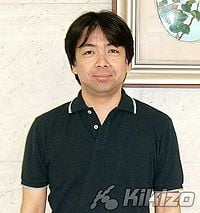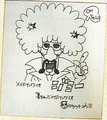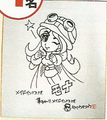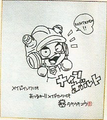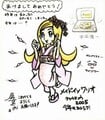Ko Takeuchi: Difference between revisions
(Undo revision 3964691 by Wiki mass attack (talk)) Tag: Undo |
(fixed another broken link) |
||
| (13 intermediate revisions by 8 users not shown) | |||
| Line 1: | Line 1: | ||
[[File:Ko Takeuchi.jpg|thumb|Ko Takeuchi in 2006]] | [[File:Ko Takeuchi.jpg|thumb|Ko Takeuchi in 2006]] | ||
'''Ko Takeuchi''' (竹内 高 ''Takeuchi Kō'', born November 28, 1970) is a Japanese video game designer working for [[Nintendo]] | '''Ko Takeuchi''' (竹内 高 ''Takeuchi Kō'', born November 28, 1970) is a Japanese video game designer working for [[Nintendo]]. He specializes in video games and music.<ref>[https://web.archive.org/web/20100915163215/http://www.mata-web.com/anime-manga/index.php?option=com_content&view=article&id=225&catid=70&Itemid=70 Ko Takeuchi's involvement in the Japan Expo 2008 at Mata-web (French)]</ref> Takeuchi is one of the key developers of the [[WarioWare (series)|''WarioWare'' series]]. Among his most important work in terms of Nintendo games is the character design of the ''WarioWare'' and ''[[rhythmheaven:Rhythm Heaven (series)|Rhythm Heaven]]'' series. The first Nintendo games Ko Takeuchi was involved with were ''Tottoko [[wikipedia:Hamtaro|Hamtaro]]: Tomodachi Daisaku Ikusa Dechu'' and ''[[Wario Land 4]]''. In 2001, Takeuchi founded his own design studio Kokosac along with his wife, Sachiko Imai, a visual artist herself. | ||
==Life and work== | ==Life and work== | ||
Ko Takeuchi was born on November 28, 1970 in Kōchi in the Kōchi Prefecture of [[Japan]].<ref>[ | Ko Takeuchi was born on November 28, 1970 in Kōchi in the Kōchi Prefecture of [[Japan]].<ref>[https://archive.is/zY15n Ko Takeuchi's profile at Kokosac.com (Japanese)]</ref> Early in his life, he became interested in video games, such as the [[Game & Watch]] handhelds and the [[Family Computer|Famicom]] console. Takeuchi graduated from the Horikoshi High School in [[Tokyo]], later he traveled to the [[United States of America]] and studied at the Cartooning Faculty of the School of Visual Arts in [[New York City]].<ref name="japan_expo_interview">[https://web.archive.org/web/20100915163215/http://www.mata-web.com/anime-manga/index.php?option=com_content&view=article&id=225&catid=70&Itemid=70 Interview with Ko Takeuchi at Mata-web (French)]</ref> | ||
After his return to Japan, he applied to different companies related to visual arts, including at least one game company, the now-defunct developer [[wikipedia:Superwarp|Warp]]. He joined said company and entered the video game industry this way.<ref name="gpara_interview">[http://www.gpara.com/contents/creator/bn_206.htm Interview with Ko Takeuchi at Gpara.com (Japanese)]</ref> During his time at Warp, Takeuchi worked on [[wikipedia: | After his return to Japan, he applied to different companies related to visual arts, including at least one game company, the now-defunct developer [[wikipedia:Superwarp|Warp]]. He joined said company and entered the video game industry this way.<ref name="gpara_interview">[https://web.archive.org/web/20081202142300/http://www.gpara.com/contents/creator/bn_206.htm Interview with Ko Takeuchi at Gpara.com (Japanese)]</ref> During his time at Warp, Takeuchi worked on [[wikipedia:Dreamcast|Dreamcast]] games, including ''[[wikipedia:D2 (video game)|D2]]'', of which he was one of the designers.<ref name="japan_expo_interview"/> Afterwards, he joined Nintendo in 2000. The first Nintendo game he was involved with is ''Tottoko [[wikipedia:Hamtaro|Hamtaro]]: Tomodachi Daisaku Ikusa Dechu'', released in the same year. Takeuchi took the role of assistant director. The next game he worked on is ''[[Wario Land 4]]'', for which he was responsible for the background graphics.<ref name="gpara_interview"/> In the year of the game's release, 2001, Ko Takeuchi and his wife Sachiko Imai founded a design studio, Kokosac, located in [[wikipedia:Kyoto, Japan|Kyoto, Japan]].<ref name="japan_expo_interview"/> | ||
[[File:Group WWMM.jpg|210px|thumb|The original cast of ''WarioWare'', designed by Ko Takeuchi]] | [[File:Group WWMM.jpg|210px|thumb|The original cast of ''WarioWare'', designed by Ko Takeuchi]] | ||
Takeuchi is responsible for the character design in all games of the ''WarioWare'' series, starting with ''[[WarioWare, Inc.: Mega Microgame$!]]'' released in 2003, and is a key designer of the franchise in general. He designed characters for the ''[[WarioWare (series)|WarioWare]]'' series such as [[Jimmy T]], [[Mona]], [[9-Volt]], and [[Ashley]].<ref>[[List of WarioWare, Inc.: Mega Microgame$! staff|Staff Credits of ''WarioWare, Inc.: Mega Microgame$!'']] and subsequent ''WarioWare'' games</ref> The title character [[Wario]] was also given a new appearance by Takeuchi for the series, wearing a biker outfit. During the development of ''WarioWare, Inc.: Mega Microgame$!'', Ko Takeuchi also sometimes worked with [[Hiroji Kiyotake]], the original designer of Wario.<ref name="gpara_interview"/> He created the artwork for the [[Nintendo Kids Space#Ashley no Halloween Night|Ashley no Halloween Night]] and [[Nintendo Kids Space#Barbara & Ashley|Barbara & Ashley]] online comics. | Takeuchi is responsible for the character design in all games of the ''WarioWare'' series, starting with ''[[WarioWare, Inc.: Mega Microgame$!]]'' released in 2003, and is a key designer of the franchise in general. He designed characters for the ''[[WarioWare (series)|WarioWare]]'' series such as [[Jimmy T]], [[Mona]], [[9-Volt]], and [[Ashley]].<ref>[[List of WarioWare, Inc.: Mega Microgame$! staff|Staff Credits of ''WarioWare, Inc.: Mega Microgame$!'']] and subsequent ''WarioWare'' games</ref> The title character [[Wario]] was also given a new appearance by Takeuchi for the series, wearing a biker outfit. During the development of ''WarioWare, Inc.: Mega Microgame$!'', Ko Takeuchi also sometimes worked with [[Hiroji Kiyotake]], the original designer of Wario.<ref name="gpara_interview"/> He created the artwork for the [[Nintendo Kids Space#Ashley no Halloween Night|Ashley no Halloween Night]] and [[Nintendo Kids Space#Barbara & Ashley|Barbara & Ashley]] online comics. Additionally, he voices [[Joe]] in the Japanese version of the ''WarioWare'' series starting with ''[[WarioWare Gold]]''. | ||
His characters, be it in video games or other media, are usually based on real people, including his friends, colleagues, and people he met on the street.<ref name="japan_expo_interview"/> When Ko Takeuchi sees a fascinating person who might be the inspiration for a new character, he draws them in his small sketchbook.<ref name="gpara_interview"/> Takeuchi's style, which is commonly seen as "cute", is influenced by artists such as [[wikipedia:Akira Toriyama|Akira Toriyama]] and [[Yoichi Kotabe]].<ref name="japan_expo_interview"/> | His characters, be it in video games or other media, are usually based on real people, including his friends, colleagues, and people he met on the street.<ref name="japan_expo_interview"/> When Ko Takeuchi sees a fascinating person who might be the inspiration for a new character, he draws them in his small sketchbook.<ref name="gpara_interview"/> Takeuchi's style, which is commonly seen as "cute", is influenced by artists such as [[wikipedia:Akira Toriyama|Akira Toriyama]] and [[Yoichi Kotabe]].<ref name="japan_expo_interview"/> | ||
| Line 30: | Line 31: | ||
*''[[Super Smash Bros. Ultimate]]'' - Original Game Supervisor | *''[[Super Smash Bros. Ultimate]]'' - Original Game Supervisor | ||
*''[[WarioWare: Get It Together!]]'' - Character Designer | *''[[WarioWare: Get It Together!]]'' - Character Designer | ||
*''[[WarioWare: Move It!]]'' - Character Designer, Character Voice (Joe, Japanese dub) | |||
==Gallery== | |||
<gallery> | |||
ND WWIMPG Takeuchi Present Drawing 1.png|[[Jimmy T]] as drawn by Ko Takeuchi, used for one of the present of a lottery activity initiated by ''Nintendo DREAM'' | |||
ND WWIMPG Takeuchi Present Drawing 2.png|[[Mona]] as drawn by Ko Takeuchi, used for one of the present of a lottery activity initiated by ''Nintendo DREAM'' | |||
ND WWIMPG Takeuchi Present Drawing 3.png|[[9-Volt]] as drawn by Ko Takeuchi, used for one of the present of a lottery activity initiated by ''Nintendo DREAM'' | |||
WWTouched Signed Edition Takeuchi Signature.jpg|A signature of Ko Takeuchi with a drawing of [[Kat & Ana|Kat]], from a signed copy of ''[[WarioWare: Touched!]]'' | |||
ND WWTouched 2005 Nengajo.jpg|2005 ''nengajō'' for ''Nintendo DREAM'' based on ''WarioWare: Touched!'' from the developers of the game | |||
Nindori Exposition Entrance Takeuchi Orbulon Doodle.jpg|A doodle of [[Orbulon]] by Ko Takeuchi, from the whiteboard at the entrance of Nindori Exposition | |||
</gallery> | |||
==Trivia== | ==Trivia== | ||
| Line 39: | Line 51: | ||
==External links== | ==External links== | ||
*[http://kokosac.tumblr.com/ Official Website of Kokosac] (Japanese, not related to Ko Takeuchi's work at Nintendo) | *[http://kokosac.tumblr.com/ Official Website of Kokosac] (Japanese, not related to Ko Takeuchi's work at Nintendo) | ||
*[https://twitter.com/kosan_takeuchi | *[https://twitter.com/kosan_takeuchi X account] | ||
*[https://www.instagram.com/kosan_takeuchi Instagram account] | *[https://www.instagram.com/kosan_takeuchi Instagram account] | ||
Latest revision as of 08:00, March 19, 2024
Ko Takeuchi (竹内 高 Takeuchi Kō, born November 28, 1970) is a Japanese video game designer working for Nintendo. He specializes in video games and music.[1] Takeuchi is one of the key developers of the WarioWare series. Among his most important work in terms of Nintendo games is the character design of the WarioWare and Rhythm Heaven series. The first Nintendo games Ko Takeuchi was involved with were Tottoko Hamtaro: Tomodachi Daisaku Ikusa Dechu and Wario Land 4. In 2001, Takeuchi founded his own design studio Kokosac along with his wife, Sachiko Imai, a visual artist herself.
Life and work[edit]
Ko Takeuchi was born on November 28, 1970 in Kōchi in the Kōchi Prefecture of Japan.[2] Early in his life, he became interested in video games, such as the Game & Watch handhelds and the Famicom console. Takeuchi graduated from the Horikoshi High School in Tokyo, later he traveled to the United States of America and studied at the Cartooning Faculty of the School of Visual Arts in New York City.[3]
After his return to Japan, he applied to different companies related to visual arts, including at least one game company, the now-defunct developer Warp. He joined said company and entered the video game industry this way.[4] During his time at Warp, Takeuchi worked on Dreamcast games, including D2, of which he was one of the designers.[3] Afterwards, he joined Nintendo in 2000. The first Nintendo game he was involved with is Tottoko Hamtaro: Tomodachi Daisaku Ikusa Dechu, released in the same year. Takeuchi took the role of assistant director. The next game he worked on is Wario Land 4, for which he was responsible for the background graphics.[4] In the year of the game's release, 2001, Ko Takeuchi and his wife Sachiko Imai founded a design studio, Kokosac, located in Kyoto, Japan.[3]
Takeuchi is responsible for the character design in all games of the WarioWare series, starting with WarioWare, Inc.: Mega Microgame$! released in 2003, and is a key designer of the franchise in general. He designed characters for the WarioWare series such as Jimmy T, Mona, 9-Volt, and Ashley.[5] The title character Wario was also given a new appearance by Takeuchi for the series, wearing a biker outfit. During the development of WarioWare, Inc.: Mega Microgame$!, Ko Takeuchi also sometimes worked with Hiroji Kiyotake, the original designer of Wario.[4] He created the artwork for the Ashley no Halloween Night and Barbara & Ashley online comics. Additionally, he voices Joe in the Japanese version of the WarioWare series starting with WarioWare Gold.
His characters, be it in video games or other media, are usually based on real people, including his friends, colleagues, and people he met on the street.[3] When Ko Takeuchi sees a fascinating person who might be the inspiration for a new character, he draws them in his small sketchbook.[4] Takeuchi's style, which is commonly seen as "cute", is influenced by artists such as Akira Toriyama and Yoichi Kotabe.[3]
During his studies, Ko Takeuchi had to put aside his passion for playing video games because he was so busy. Today, he still plays video games as time permits. Takeuchi has specifically mentioned his enthusiasm for the Mother series, referring to the game Mother as a masterpiece and stating that he played through Mother 2 (EarthBound) three times.[4][3]
Games credited[edit]
- Wario Land 4 - Designer
- WarioWare, Inc.: Mega Microgame$! - Character Design, Game Design, Graphic Design
- WarioWare, Inc.: Mega Party Game$! - Art Director, Graphic Design, Voice
- WarioWare: Twisted! - Game Design, Design, Design Director, Character Design, Character Voice
- WarioWare: Touched! - Game Design, Design, Character Design
- WarioWare: Smooth Moves - Game Design, Character Design
- Super Smash Bros. Brawl - Supervisor (Original Games)
- WarioWare: Snapped! - Character Design
- WarioWare: D.I.Y. - Character Design
- Game & Wario - Character Design
- Super Smash Bros for Nintendo 3DS / Wii U - Supervisor (Original Games) (drew the alternate poses of the WarioWare and Rhythm Heaven trophies[6])
- Rhythm Heaven Megamix - Art Director, Voice Talent
- Nintendo Badge Arcade - Badge Design
- WarioWare Gold - Character Designer, Character Voice (Joe, Japanese dub)
- Super Smash Bros. Ultimate - Original Game Supervisor
- WarioWare: Get It Together! - Character Designer
- WarioWare: Move It! - Character Designer, Character Voice (Joe, Japanese dub)
Gallery[edit]
Jimmy T as drawn by Ko Takeuchi, used for one of the present of a lottery activity initiated by Nintendo DREAM
Mona as drawn by Ko Takeuchi, used for one of the present of a lottery activity initiated by Nintendo DREAM
9-Volt as drawn by Ko Takeuchi, used for one of the present of a lottery activity initiated by Nintendo DREAM
A signature of Ko Takeuchi with a drawing of Kat, from a signed copy of WarioWare: Touched!
A doodle of Orbulon by Ko Takeuchi, from the whiteboard at the entrance of Nindori Exposition
Trivia[edit]
- When Ko Takeuchi tested WarioWare: Snapped! during its development, he got angry at the slideshow at the end depicting himself and yelled "What the?! You darn thing!" and "No one said anything about this!"[7]
References[edit]
- ^ Ko Takeuchi's involvement in the Japan Expo 2008 at Mata-web (French)
- ^ Ko Takeuchi's profile at Kokosac.com (Japanese)
- ^ a b c d e f Interview with Ko Takeuchi at Mata-web (French)
- ^ a b c d e Interview with Ko Takeuchi at Gpara.com (Japanese)
- ^ Staff Credits of WarioWare, Inc.: Mega Microgame$! and subsequent WarioWare games
- ^ Ko Takeuchi's answer to a question on Twitter
- ^ Iwata Asks: Nintendo DSi, Volume 5 - WarioWare: Snapped! (page 3) at NintendoDS.com
External links[edit]
- Official Website of Kokosac (Japanese, not related to Ko Takeuchi's work at Nintendo)
- X account
- Instagram account
